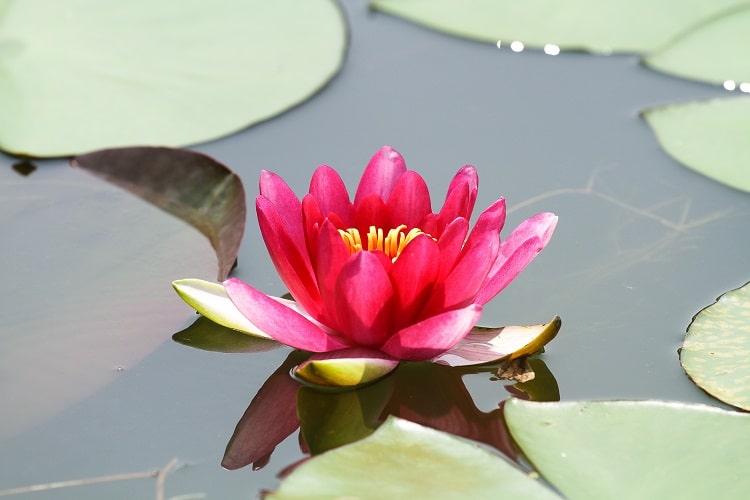How to Grow Lotus Flower in Your Garden?

The lotus flower (Nelumbo spp.) is not only beautiful and unique, but it also holds an enormous symbolic heritage that spans thousands of years. Native to India and Viet Nam, the lotus flower is considered sacred and is revered all across the middle east. This aquatic perennial symbolizes purity, fertility, rebirth, wealth, and many other things. The unique habits of this mysterious plant make it a highly prized addition to any outdoor or indoor garden.
Lotus flowers are not only beautiful and unique, but they also hold spiritual and cultural significance in many parts of the world. Growing lotus flowers may seem daunting, but with the right guidance, it is an easy process. In this article, we will guide you through the process of growing lotus flowers step by step, from selecting the right variety to caring for your plants.
Follow these tips and learn how to grow a lotus flower in your garden or home.
Selecting the Right Variety
There are two main types of lotus flowers: Nelumbo nucifera and Nelumbo lutea. Nelumbo nucifera is the most commonly grown variety and is also known as the sacred lotus. Nelumbo lutea, also known as the American lotus, is native to North America. When selecting a variety, make sure to choose one that is suitable for your climate zone.
Start Your Lotus Flower with Seeds
Seeds can be purchased from an online retailer or any garden supply center. Place lotus seeds in a glass or bowl of warm water. Seeds that float are infertile and should be removed from the water and discarded. Change the water every day until you see roots emerge from the seed.
Growing Location
Lotus flowers require full sun and warm temperatures to thrive. Choose a location in your garden that receives at least 6 hours of sunlight per day. The ideal water depth for lotus plants is between 1 and 4 feet, so choose a location that allows for this depth of water. If you do not have a natural body of water in your garden, you can grow lotus flowers in containers that are at least 24 inches in diameter and 12 inches deep.
- Place the pot containing the new transplant in a container that holds two inches of water. The water should be warm and kept at a consistent two-inch depth.
- Place the container in a sunny location where the plant will receive at least 8 hours a day of sunlight.
- The lotus plant will remain here until it develops more roots and leaves.
Final Growing Location
- Once the seed has developed a strong root system and large leaves, it can be placed in its final aquatic home.
- Prepare the final home for the lotus plant by placing two inches of clay in the bottom of an outdoor water feature or a non-draining container for indoor growth. Place the plant on top of the clay.
- Gently spread out roots and cover them with a thin layer of clay.
- Cover the clay with half an inch of pea gravel. This will keep the clay in place and the water clear.
- Fill the water feature/container with enough water to reach the bottom of the lotus flower so it can float. Add water as needed to keep the plant floating.
- The aquatic plant will probably not bloom in the first year.
Preparing the Soil
Lotus flowers grow best in nutrient-rich soil that is muddy and heavy. Before planting, add organic matter to the soil to improve its fertility. You can also add a slow-release fertilizer to provide additional nutrients for your plants. Lotus flowers prefer a soil pH between 6.5 and 7.5, so make sure to test your soil before planting.
Planting the Lotus Tubers
Lotus tubers should be planted in early spring when the water temperature is around 70 degrees Fahrenheit. Plant the tubers in a pot or directly in the soil at a depth of 2-4 inches. Make sure to keep the soil moist at all times. If you are planting in a container, fill it with at least 6 inches of soil and place the tuber in the center. Cover the tuber with soil and add water until the container is filled to the appropriate depth.
Dealing with Common Problems
Lotus plants are relatively pest and disease-resistant, but they can still be affected by common garden problems. If you notice yellowing leaves or stunted growth, this may be a sign of a nutrient deficiency. Apply a balanced fertilizer to provide your plants with the necessary nutrients. If you notice any pests, such as aphids or spider mites, treat your plants with a natural insecticide. To prevent fungal diseases, make sure to avoid getting water on the leaves of your plants.
Transplanting
Fill a small 4-5 inch pot with loose garden loam and make an indention in the top with your thumb. Gently lift the sprouted lotus seed from the water and place it in the indentation. Lightly cover roots with garden loam. If the seed has already developed leaves, be careful not to cover them with loam.
Caring for Your Lotus Plants
Lotus plants require regular maintenance to thrive. Make sure to keep the soil moist at all times, but avoid overwatering as this can lead to root rot. Fertilize your plants every 4-6 weeks with a slow-release fertilizer. Prune any dead leaves or flowers to encourage new growth. If you live in an area with cold winters, you may need to overwinter your lotus plants indoors or in a heated greenhouse.
After Care
- Feed an established lotus flower once a month during the growing season.
- Trim off yellow foliage in the fall.
- Over-winter in deep ponds that don’t freeze, or remove plants and place them in a cool, dry location until spring.
Harvesting Your Lotus Flowers
Lotus flowers bloom in mid-summer and continue blooming until early fall. When the flowers begin to wilt, you can cut them and use them as a decorative element in your home or garden. The seeds of the lotus plant are also edible and can be harvested for culinary purposes. Once the seed pods have turned brown, you can harvest them and remove the seeds
Basic Guide To Growing Lotuses Flowers
 |
||
Growing lotuses (Nelumbo) can be easy and fun either from a tuber or from seed. If you grow from a tuber, you will have an exact duplicate of the parent, in many cases a named cultivar. If growing from seed, please keep in mind that, even if a name comes with the seeds, the offspring will be quite variable because of the genetics involved and they can’t retain the cultivar name.
| Your garden tuber should be firm and have a healthy growing tip. Be very careful not to damage the tips as they are quite fragile and critical to growing the plant. |  |
|
Choose round containers for lotuses so future runners don’t get jammed in square corners. Soil can be anything readily available but avoid potting soils that contain light materials that will float away. Plant your lotus tuber in the soil with the growing tip at the soil level and pointed toward the center of the pot. Fertilize regularly during the growing season with tablets designed for aquatic plants.
Lotuses can be grown in the main pond, a separate small pond, or self-contained in decorative pots for the patio or deck. Water over the pot or soil in the container should be at least 8″ deep. If growing in the pond, be sure that runners don’t escape the container and invade the pond. They can overwhelm other pond plants.
With some varieties, it can take several years for them to bloom, and this can also be dependent on your location. In the meantime, you can enjoy the spectacular foliage, almost enough by itself!
Baby Lotus Care In Winter
Baby lotus is too small to winter in a pond, this first season. Plant each baby in a 4-inch pot with a mixture of 1/3 soil, 2/3 sand, and about a tablespoonful of cheap kitty litter … for the clay. Sink them in an aquarium or deep tub so they are about 4 inches underwater.
Grow lights are helpful, but not too close. You will dehydrate the little leaves. Add an air stone bubblier to circulate the water slowly, and if the setup is in a basement or cold area, an in-tank heater will keep the temperature constant. Don’t worry about the baby lotus going dormant. Just let them decide when that happens. As the days get shorter, turn you grow lights off as the sun goes down and on at sunrise.
Keep your water clean. Never use softened tap water. Too many chemicals will do the babies great harm. Catch rainwater or use well water. If you add some floating plants and a few fish, you will have created a mini-pond environment to enjoy throughout the cold winter days.
Too much work you say! I bet you will change your mind when you see that baby lotus put out the first new spring leaf, and your now-teenage lotus is ready for the big pond on the first warm day in spring. Remember to treat them like children. Keep ’em clean, and warm, and resist overfeeding them. May you enjoy each Lotus to its fullest as they grow and mature and shower you with beautiful blooms.
Read More: A Guide To The Benefits Of Having A Flower Garden
Blue Lotus Flower Extract used in Kratom Fusion
 The Blue Lotus Flower, also known as Nymphaea Caerulea, is used to make blue lotus tea, wine, and martinis, and blended with Mitragyna Speciosa to make kratom fusions.
The Blue Lotus Flower, also known as Nymphaea Caerulea, is used to make blue lotus tea, wine, and martinis, and blended with Mitragyna Speciosa to make kratom fusions.
For alcoholic drinks, the flower petals are steeped or soaked for as many as two to three weeks. For tea, it is prepared similarly to any ordinary tea, with boiling water.
To create a kratom fusion, lotus extract is prepared by soaking the stems and petals in alcohol, citrus juice, and water for one to thirty days. The flower stems and petals are then removed leaving only the liquid which is heated to a light boil until all liquid has been evaporated leaving the reduced blue lotus concentrate. It’s then ground into a powder and mixed with kratom to create the popular Kratom Indra Fusion
Which is Designed for a Moderate and Relaxing Effect
 Blue lotus is primarily known for its mild sedative effects, but some recent studies have shown the blue lotus flower to have mild psychoactive properties.
Blue lotus is primarily known for its mild sedative effects, but some recent studies have shown the blue lotus flower to have mild psychoactive properties.
Considered an Ethnobotanical and found on the shores of the Nile River, the mildly sedating effects of having been known and used for centuries by the Egyptians.
The Blue Lotus is also used in perfumes and aromatherapy. The flower opens in the morning and closes in the early evening which was believed by the Egyptians to hold the key to the creation of the universe.
The Lotus Flower Color Meanings
The color of the lotus flower holds symbolic meanings in various cultures. Here are some common color meanings associated with lotus flowers:
- White: White lotus flowers are often associated with purity, spiritual perfection, and enlightenment. They are often depicted as a representation of the highest state of spiritual awakening in Buddhism and Hinduism.
- Pink: Pink lotus flowers are often associated with purity of the heart, love, compassion, and the divine qualities of the Buddha or other deities. Pink lotus flowers are commonly depicted in art and are often used in religious ceremonies to represent devotion and affection.
- Red: Red lotus flowers are often associated with passion, love, and compassion. They can also represent the qualities of the heart, such as courage and bravery. In Buddhism, red lotus flowers are believed to symbolize the original nature of the heart, which is pure and compassionate, even amidst the challenges of life.
- Blue: Blue lotus flowers are often associated with wisdom, knowledge, and the victory of the spirit over the senses. They can symbolize the pursuit of enlightenment and the transformation of the mind toward higher consciousness.
- Yellow: Yellow lotus flowers are often associated with spiritual enlightenment, knowledge, and learning. They can also represent the mind and intellect, and the quest for understanding and wisdom.
It’s important to note that the meanings associated with lotus flower colors can vary depending on cultural and religious interpretations. While these are common color meanings, they may not be universal and may hold different significance in different traditions or contexts.
Facts About The Lotus Flower
- Symbolism: The lotus flower is highly regarded as a symbol of purity, enlightenment, and rebirth in many cultures and religions, including Buddhism, Hinduism, and Egyptian mythology.
- Growth: The lotus flower is an aquatic plant that grows in muddy or murky water but rises above the surface to bloom into a beautiful and pristine flower. This has led to its symbolic representation of purity and enlightenment emerging from difficult or challenging circumstances.
- Colors: Lotus flowers come in various colors, including white, pink, red, blue, and yellow. Each color carries its own symbolic meaning, with white representing purity and spiritual perfection, pink symbolizing purity of the heart, red representing love and compassion, blue symbolizing wisdom and knowledge, and yellow representing enlightenment.
- Sacredness: The lotus flower is considered sacred in many cultures and is often used in religious rituals, ceremonies, and art. It is also a popular motif in traditional and contemporary art and architecture, symbolizing beauty, grace, and spiritual awakening.
- Medicinal Properties: Various parts of the lotus plant, including its flowers, seeds, and roots, are used in traditional medicine for their potential medicinal properties. They are believed to have antioxidant, anti-inflammatory, and anti-aging properties, and are used to treat a variety of ailments such as diarrhea, fever, and skin conditions.
- Longevity: The lotus flower is known for its longevity and ability to remain fresh and beautiful even after being plucked. This has led to its association with immortality, resilience, and perseverance.
- Cultural Significance: The lotus flower holds special cultural significance in many countries, including China, India, Japan, Vietnam, and Egypt. It is often used in religious ceremonies, festivals, and celebrations, and is considered a powerful symbol of spirituality, enlightenment, and purity.
- Ecological Importance: Lotus flowers play a vital role in aquatic ecosystems as they provide habitat and food for various animals, including insects, birds, and fish. They also help maintain water quality by absorbing excess nutrients and pollutants from the water.
- Edible Uses: Lotus flowers are also used for culinary purposes in some cultures. The seeds of the lotus flower, known as lotus nuts or lotus seeds, are often used in soups, desserts, and traditional medicines in Asian cuisines.
- Artistic Inspiration: The lotus flower has been a popular subject in literature, poetry, music, and visual arts for centuries. Its beauty, symbolism, and cultural significance have inspired many artists and writers to depict it in their works as a symbol of purity, spirituality, and enlightenment.
These are some interesting facts about the lotus flower, a revered and cherished symbol in many cultures around the world.
For more Information Watch this Video :









